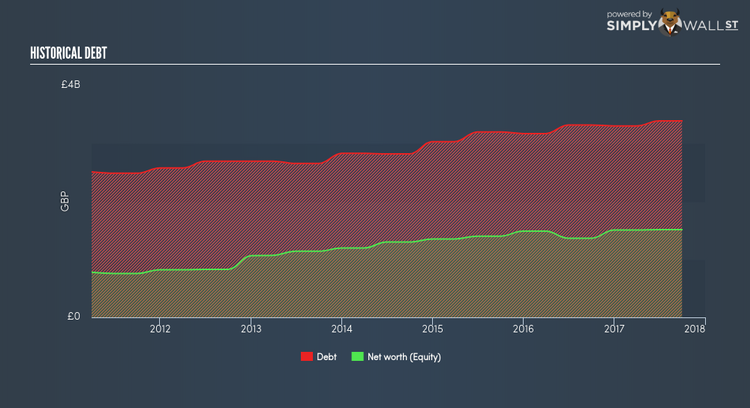Is Pennon Group Plc’s (LON:PNN) Balance Sheet Strong Enough To Weather A Storm?

Small-caps and large-caps are wildly popular among investors; however, mid-cap stocks, such as Pennon Group Plc (LSE:PNN) with a market-capitalization of UK£2.55B, rarely draw their attention. Surprisingly though, when accounted for risk, mid-caps have delivered better returns compared to the two other categories of stocks. PNN’s financial liquidity and debt position will be analysed in this article, to get an idea of whether the company can fund opportunities for strategic growth and maintain strength through economic downturns. Remember this is a very top-level look that focuses exclusively on financial health, so I recommend a deeper analysis into PNN here. Check out our latest analysis for Pennon Group
Does PNN generate enough cash through operations?
PNN’s debt level has been constant at around UK£3.31B over the previous year comprising of short- and long-term debt. At this constant level of debt, the current cash and short-term investment levels stands at UK£374.30M for investing into the business. On top of this, PNN has generated UK£318.70M in operating cash flow in the last twelve months, resulting in an operating cash to total debt ratio of 9.64%, signalling that PNN’s operating cash is not sufficient to cover its debt. This ratio can also be interpreted as a measure of efficiency as an alternative to return on assets. In PNN’s case, it is able to generate 0.096x cash from its debt capital.
Does PNN’s liquid assets cover its short-term commitments?
Looking at PNN’s most recent UK£519.90M liabilities, the company has maintained a safe level of current assets to meet its obligations, with the current ratio last standing at 1.87x. Usually, for Water Utilities companies, this is a suitable ratio as there’s enough of a cash buffer without holding too capital in low return investments.
Does PNN face the risk of succumbing to its debt-load?
Since total debt levels have outpaced equities, PNN is a highly leveraged company. This is not uncommon for a mid-cap company given that debt tends to be lower-cost and at times, more accessible. We can test if PNN’s debt levels are sustainable by measuring interest payments against earnings of a company. Ideally, earnings before interest and tax (EBIT) should cover net interest by at least three times. For PNN, the ratio of 5.45x suggests that interest is appropriately covered, which means that debtors may be willing to loan the company more money, giving PNN ample headroom to grow its debt facilities.
Next Steps:
PNN’s debt and cash flow levels indicate room for improvement. Its cash flow coverage of less than a quarter of debt means that operating efficiency could be an issue. However, the company exhibits proper management of current assets and upcoming liabilities. I admit this is a fairly basic analysis for PNN’s financial health. Other important fundamentals need to be considered alongside. I recommend you continue to research Pennon Group to get a more holistic view of the stock by looking at:
Future Outlook: What are well-informed industry analysts predicting for PNN’s future growth? Take a look at our free research report of analyst consensus for PNN’s outlook.
Valuation: What is PNN worth today? Is the stock undervalued, even when its growth outlook is factored into its intrinsic value? The intrinsic value infographic in our free research report helps visualize whether PNN is currently mispriced by the market.
Other High-Performing Stocks: Are there other stocks that provide better prospects with proven track records? Explore our free list of these great stocks here.
To help readers see pass the short term volatility of the financial market, we aim to bring you a long-term focused research analysis purely driven by fundamental data. Note that our analysis does not factor in the latest price sensitive company announcements.
The author is an independent contributor and at the time of publication had no position in the stocks mentioned.

